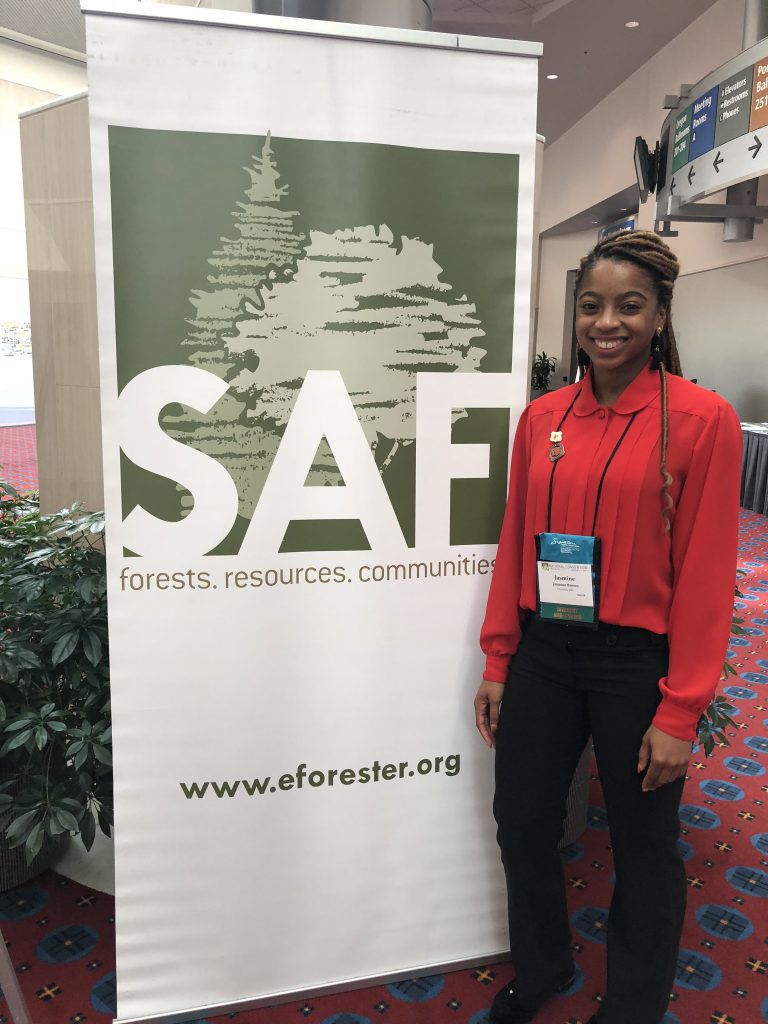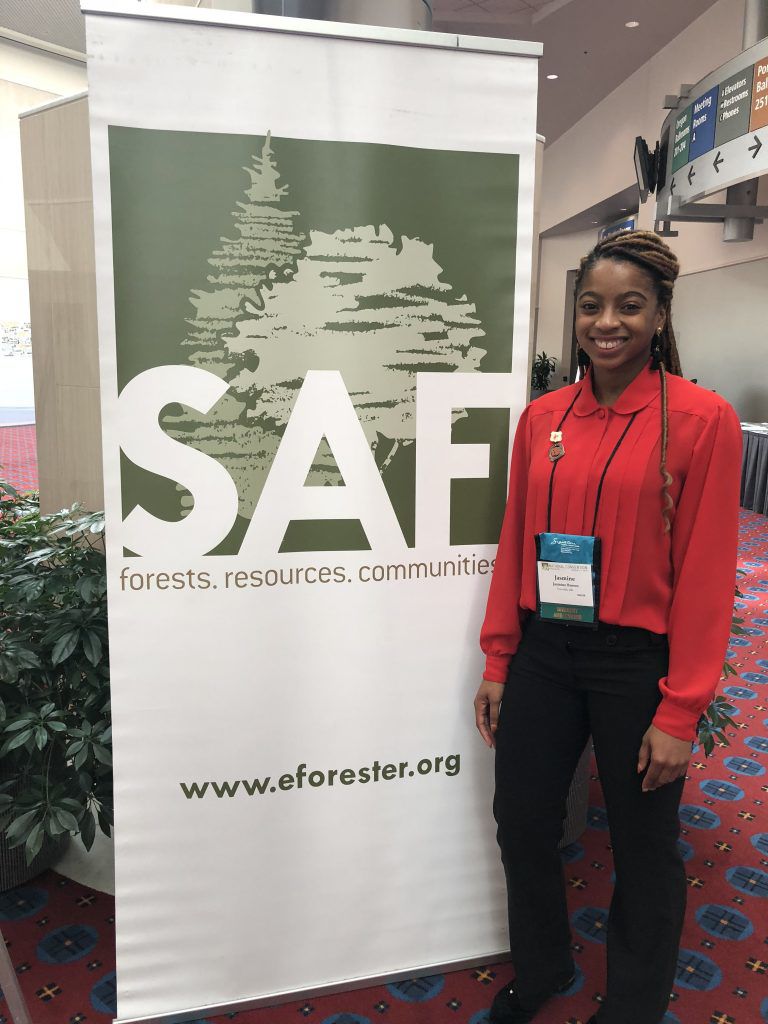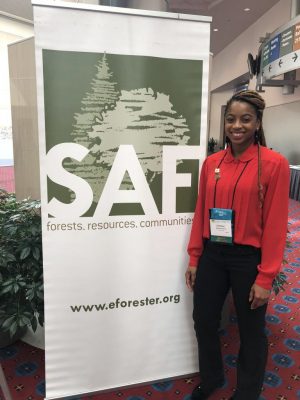Episode 22: Language is a barrier to diversity and inclusion in natural resources research
September 24, 2019
As a 3rd year Master’s student in the Department of Forest Ecosystems & Society, Jasmine Brown is investigating diversity and inclusion in the field of natural resources. Her research has consisted of examining how language usage reinforces barriers to inclusion. For example, the usage of terms such as ‘women or minorities’ fails to capture identities that exist at the intersection of both categories. Efforts to include members of marginalized groups still fall short, as current language usage does not include people whose identities intersect multiple categories. As a Black woman working in forestry, Jasmine’s understanding and lived experience of the forestry profession is acutely different from the typical experience of a White male. Through her research, Jasmine is examining what it means to be a Black woman in forestry. Although the demographics of who is contributing to natural resources research is slowly changing, language usage in the field has remained somewhat static. Conventional language used in natural resources is not connected to the historical trauma associated with forest spaces and requires change moving forward.
How Jasmine gathered the data
At the beginning of her project, Jasmine found that language used in natural resources research is ambiguous. She explains how in medical science, “a kneecap refers to a specific body part, and leaves no room for interpretation. However, in natural resources, the term ‘diversity,’ for example, might have multiple meanings depending on the context. It might refer to habitat diversity, biodiversity, and wildlife diversity in addition to diversity of social identities such as race, ethnicity, and gender”. Despite being excited to learn about how diversity and inclusion is discussed in natural resources, Jasmine struggled to find a comprehensive body of text to base her work on. So she ended up having to compile the sources on her own. While conducting a systematic review, she was able to develop targeted search terms to evaluate existing research about diversity and inclusion of researchers in natural resources. A systematic review is comparable to a literature review, and is a method typically used in medical and social science to collect and evaluate published research using specific criteria. The advantage of a systematic review is that it provides a method to systematically and methodically identify relevant literature.
To compile a body of literature for her systematic review, Jasmine looked for signifiers, or markers, of diversity in natural resources, such as ‘underrepresented, women, females, minorities.’ Researchers told Jasmine she would have difficulty locating articles on diversity in natural resources, but Jasmine found over 260 articles! The literature she found is a combination of published sources, including scientific journals, and unpublished sources, including magazines, presentations, conference papers, theses, and technical reports.
By evaluating the body of literature, she has identified which research methods are most popular for investigating diversity and inclusion in natural resources. Jasmine unearthed program evaluations by practitioners in the field, consisting of a summary of their successful implementation of diversity and inclusion programs. Methods used by practitioners in the field tended to be different than methods employed by scientific researchers. She observed that the scientific methods used by natural resources researchers have changed considerably over time. She also indicated that editorials about diversity and inclusion are abundant. Although authors may be highly educated researchers, the methods used to derive conclusions in editorial pieces are casual and less rigorous than in other standardized science disciplines.
Jasmine further investigated the institutions where authors were working, and found that the top two categories were government and academia. Then, she investigated what titles were held by the authors. Over time, position titles have become more difficult to classify. Early in the field of forestry, a researcher might be known as, ‘forester.’ Today, however, position titles are more complex and reflect hierarchical changes to the academic system. An academic title might consist of multiple categories, such as, ‘assistant professor of forestry in the department of agriculture.’
While authors are adept at identifying barriers to diversification, the application of ideas to increase diversity and inclusion is lagging behind. Much more work is required to improve implementation of ideas that will increase diversity and inclusion in natural resources.
A plan for action
Jasmine is looking forward to presenting her body of work to the larger community. She intends to present her work at the 35th Minorities in Agriculture, Natural Resources and Related Sciences (MANRRS) Conference. She also intends to publish at least 1 of 2 articles from her thesis. Her dataset of more than 260 articles will be made public after her graduation. Her hope is that other researchers trying to locate published articles about diversity and inclusion in natural resources will be able to access the information she has compiled and won’t need to spend over eight months searching for it themselves. She has recognized that the interest and need for writing about diversity and inclusion is increasing, and hopes to move the field, and the language it is built upon, forward.
Why did Jasmine want to study this topic?
As a senior undergraduate student studying forestry, Jasmine stepped out of her comfort zone and took several sociology classes about sustainability. These courses served as an illuminating accompaniment to her forestry degree, where she was introduced to forests as living ecosystems. Previously, from a forestry perspective, she was accustomed to thinking about trees in terms of their quantitative measurements and economic benefit to society. It was during this time that she became curious about how language is wielded in the forestry discipline.
Jasmine has been working with the U.S. Forest Service for close to four years. In this environment, she recognized the importance of having difficult conversations, and it is these conversations that pushed her towards grad school for a Master’s degree. Jasmine chose OSU’s Forestry & Ecosystem because of the flexibility of the program and its relevance to her specific interests concerning the ‘human dimension’ of natural resources. She hoped to pursue research at the intersection of race, gender, and ethnicity, in part, because her identity is a part of everything she does. With this in mind, her Ethnic Studies graduate minor was a perfect fit. Jasmine has assembled an interdisciplinary team with faculty from forestry, wildlife, ethnic studies and a research librarian. She has two advisors: Brenda McComb from Forestry and Dana Sanchez from Fisheries and Wildlife. She pitched her research idea about the use of language in natural resources to her advisors, and they expressed excitement about its novelty and potential for impact.
Future direction
Jasmine’s realization that her identity as a Black woman has been a barrier does make her feel more invested in and passionate about her research. The feedback and pushback she has received during her Master’s research has informed her desire to continue in academia. Now, she identifies as both a forester and a social scientist. After completing her degree, Jasmine will pursue a PhD in a related discipline, where she will continue to drive change surrounding language usage in natural resources research. Jasmine hopes to continue inspiring youth of color to become natural resource professionals.
Jasmine’s research has made her realize how important is it to consider previous scientific texts as data. Considering how many articles she’s been able to find, she places value on looking at the big picture. While it may not be easy to try evaluating criteria that have surely changed over time, Jasmine gladly accepts the challenge. As a budding researcher, her Master’s degree has taught her that there is much to be learned from previous trends when it comes to scientific standards and language use regarding diversity and inclusion in natural resources.
Join us at 7 pm on Sunday, August 4th, 2019, to hear more about Jasmine’s research and her experience as a Master’s student at OSU. Stream the show live on KBVR Corvallis 88.7FM or check out the episode as a podcast after a few weeks.




